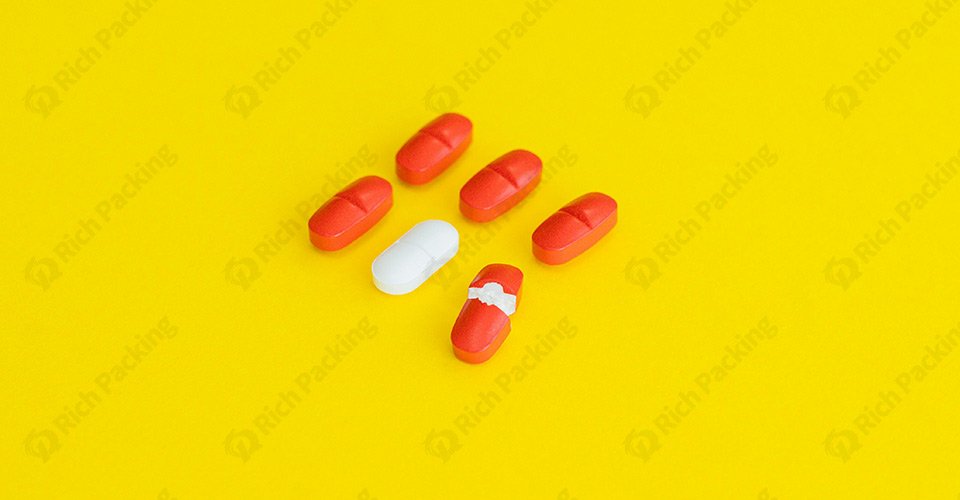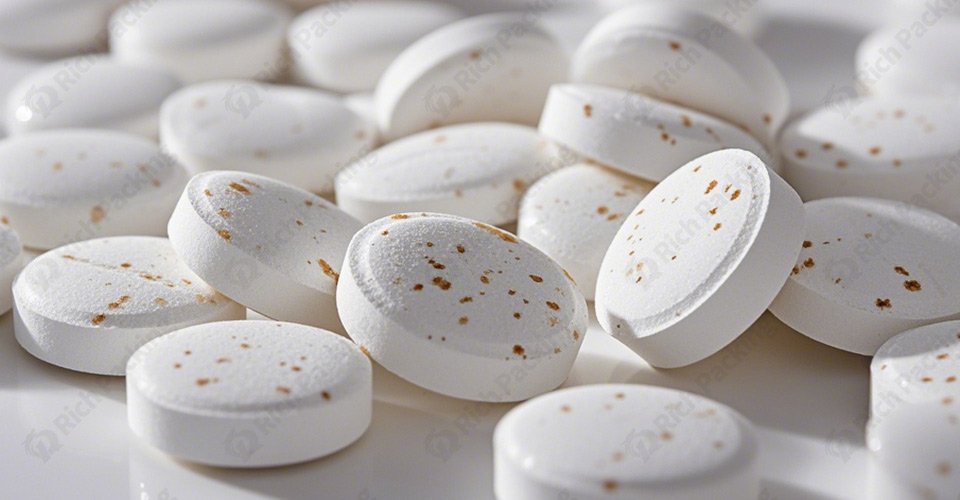Categories
New Blog
Tags
During the production of tablets in tablet presses, a variety of problems may occur, which not only affect the production efficiency, but also may affect the quality of tablets. The following is a detailed description of common problems.

Tablet splitting is more common. If the splitting position is at the top or bottom of the tablet, it is usually called capping. Uneven pressure distribution and differences in elastic recovery rates are the main causes of splitting. In addition, too many fines in the granules, granules that are too dry, weak bonding or insufficient dosage, tablets that are too thick and pressed too fast can also lead to splitting.
Tablets are not hard enough to break with a little touch, a phenomenon known as tablet loosening. The reason for this may be the loose texture of particles, uneven distribution of particle thickness, etc.
The tablet surface is adhered to a thin layer or a small portion by the punch, resulting in a rough, uneven or concave surface, or even rough or chipped edges. The main causes include insufficiently dry granules, material that does not readily absorb moisture, incorrect choice or insufficient amount of lubricant, rusty punch surfaces, or rough and unsmooth engraving.
Indicates that the tablet weight exceeds the allowable range specified in the Pharmacopoeia. The causes may be poor fluidity of the granules, low number of granules flowing into the die holes; too much fines in the granules or large difference in the size of the granules; granules in the hopper are usually too small; poor consistency of the punches and die holes, etc.
These problems are relatively common in the production of tablets in tablet presses, requiring operators to pay close attention to the production process, timely detection of problems and take appropriate measures to solve them, in order to ensure the quality of tablets and production efficiency.

Tablet fragmentation is one of the more common problems in the production of tablets by tablet presses. When tablets are split, it not only affects the appearance of the product, but also may affect the dosage accuracy and efficacy of the drug.
Uneven pressure distribution is one of the main causes of tablet fragmentation. During tablet compression, if the pressure is unevenly distributed in different parts of the tablet, it will result in higher elastic recovery in some parts and lower elastic recovery in other parts. When the pressure is relieved, the parts with high elastic recovery rates will have higher stresses, which will result in splitting of the tablet. For example, when tablets are pressed in a single-punch tablet press, the tablets are pressurized more, whereas when tablets are pressed in a rotary tablet press, the top and bottom of the tablets are pressurized more. This uneven pressure distribution may result in different elastic recovery rates for the upper and lower surfaces of the tablets, which may cause the upper surface of the tablets to move out of the die holes first and crack first.
Excessive fines are also an important cause of tablet fragmentation. If there are too many fines in the particles, during compression, the fines will hinder the bonding between the particles, making the tablet's bonding force weaker. When the pressure is lifted, the tablets are prone to fragmentation. In addition, granules that are too dry can lead to tablet fragmentation. When the particles are too dry, the plasticity of the particles becomes smaller, the elasticity increases, and it is difficult to form a close bond during the compression process, which leads to a decrease in the hardness of the tablets, and fragments will easily appear.
Solution
The following methods can be used to solve the tablet fragmentation problem. First, the use of auxiliary materials with low elasticity and high plasticity can reduce the overall elastic recovery rate of the materials and reduce the cracks of tablets due to the difference in elasticity. Second, in the case of too much fines in the granules, the excess fines can be removed by sieving or the granules can be re-granulated to make the granules more uniform in size. If the granules are too dry, the humidity can be increased appropriately to improve the plasticity of the granules. At the same time, attention should be paid to controlling the thickness and pressing speed of the tablets to avoid splitting due to too fast pressing or too thick tablets.
Loose tablets are characterized by the fact that they are not hard enough to break with a slight touch. This situation may be caused by the loose texture of the particles, uneven distribution of particle thickness.
If the particles are loose, it is difficult to form a tight bond during tablet compression, which results in a lower hardness of the tablet and a tendency for loose tablets to occur. Uneven distribution of coarse and fine particles also affects the hardness of tablets. If there are too many coarse particles and too few fine particles in the granules, the gaps between the coarse particles are large and it is difficult to form a tight bond during the tabletting process, thus leading to a decrease in the hardness of the tablet. On the contrary, if there are too many fine particles and too few coarse particles, then during the tabletting process, the bonding between the fine particles is weak, which also tends to lead to a decrease in the hardness of the tablet.
Solution
To solve the problem of loose tablets, we can start from the following aspects. First, optimize the texture of the particles by adjusting the granulation process to make the particles more compact and improve the bonding force between the particles. For example, the amount of binder or wetting agent can be increased, the appropriate binder can be selected, and the granulation process can be improved to make the particles mix more evenly. Secondly, the coarse and fine distribution of the particles can be controlled, and the size of the particles can be made more uniform by sieving and other means. For the particles with too little water content, you can spray the appropriate amount of dilute ethanol (50%-60%), mix and press the tablets to increase the plasticity and binding force of the particles.
Sticky punch during the operation of tablet press refers to the surface of tablets being stuck on a thin layer or a small part by perforator, resulting in rough, uneven or concave surface, or even rough or chipped edges. This phenomenon affects the quality of the tablet's appearance and may even affect the efficacy of the drug.
Insufficient drying of the granules is a common cause of sticky punch. If there is too much moisture in the granules, the moisture will make the granules wet during the tablet pressing process, thus increasing the adhesion between the granules and the punch, leading to the occurrence of sticky punch. In addition, improper lubricant selection or insufficient dosage can also lead to sticky punching. If the lubricant is not properly selected, it cannot effectively reduce the friction between the particles and the punch, which will lead to the occurrence of the sticky punch phenomenon. If the lubricant is insufficient, it will not provide good lubrication, which will also lead to the occurrence of sticky punch.
Solutions
The following measures can be taken to solve the sticky punch problem during tablet press operation. First, make sure that the pellets are dry enough and that the moisture content of the pellets is within a suitable range, usually around 2%-3%. Enhance the inspection of the dry granules to avoid the sticky punch caused by wet granules. Secondly, choose the correct lubricant and make sure that the dosage is sufficient. Appropriate increase in the amount of lubricant or replacement of new lubricant to remove excessive fine powder. For the case of unreasonable design of engraving and punching characters, replace the punch or change the character design accordingly. If the raw material itself has moisture attracting properties that lead to sticky punches, you can add a fixed amount of absorbent, such as adding 3% of calcium hydrogen phosphate. In addition, to ensure that the surface of the punch is smooth, if there is damage or surface finish is reduced, the punch can be wiped clean, replacement of substandard mold or a trace of liquid paraffin rubbed on the surface of the lettering punch to lubricate the character surface. At the same time, reduce the environmental humidity and operating room temperature to avoid sticky punch due to excessive humidity or high temperature.
Tablet weight discrepancy beyond the limit refers to the weight of tablets exceeding the permissible range specified in the Pharmacopoeia. This condition affects the dosage accuracy of the drug and hence the efficacy of the drug.
Poor granule flowability is a major cause of tablet weight discrepancy beyond the limit. If the granules have poor flowability, the flow rate of the granules will not be uniform during the flow into the mold holes, which will result in inconsistency in the number of granules filled into the mold holes. This can result in differences in the weight of the tablets pressed into the mold that exceed the limits. For example, if there are too many fines in the particles, or if the particles vary greatly in size, this can lead to poor flowability of the particles.
Excessive fines are also a cause of tablet weight variance outside the limits. If there are too many fines in the granules, the fines tend to fly during the tabletting process, which can lead to an unstable amount of granules filled into the mold holes. In addition, too much fine powder can affect the bonding force between the particles, making the tablets less hard and prone to problems such as fragmentation.
Solution
The following methods can be adopted to solve the problem of tablet weight difference exceeding the limit. One is to improve the flowability of the particles, for the particles with poor flowability, can be re-granulated, or add better flow additives, such as fine powder silica gel, in order to improve the flowability of the particles. The second is to remove the fines in the granules, for the case of too much fines, the excess fines should be removed or re-granulated to make the granule size more uniform. Third, ensure that the number of granules in the hopper is sufficient and stable, the granules in the hopper should always be more than 1/3, to avoid fluctuations in the weight of the tablets due to fluctuations in the weight of the feed to avoid differences in the weight of the tablets beyond the limit. Fourth, ensure good consistency of the punch and die holes. If there is a large amount of powder leakage between the outer periphery of the lower punch and the die hole wall, the punch and head die ring should be replaced to ensure adequate material filling.
Tablet presses may experience common problems during tablet production such as tablet debris, loose tablets, sticky punches while the press is running, and tablet weight variances beyond limits. The causes of these problems vary and require the operator to pay close attention to all aspects of the production process in order to identify problems and take appropriate measures to resolve them.
Proper operation and maintenance of the tablet press is critical. The operator should operate the press in strict accordance with the operating procedures and perform regular maintenance on the press, such as regularly lubricating the press column with a clean cloth, using the proper amount of release agent for the template, replacing the cooling water in a timely manner, and cleaning the press chamber. This not only reduces the occurrence of problems, but also extends the service life of the tablet press and improves production efficiency and tablet quality. For more knowledge or questions about tablet press production, you can contact us to provide you with detailed information.